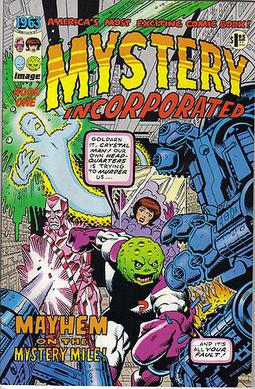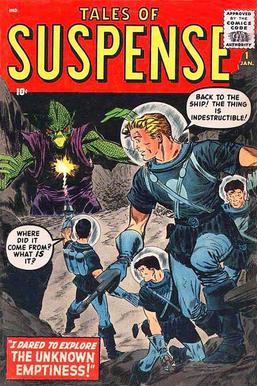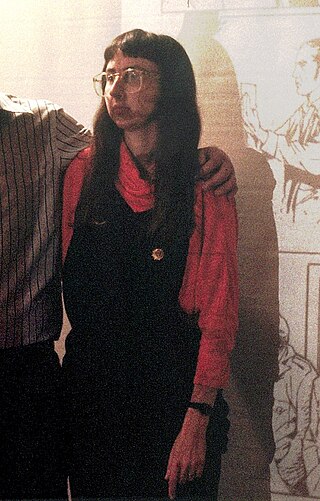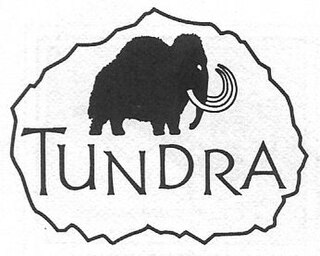Image Comics is an American comic book publisher and is the third-largest direct market comic book and graphic novel publisher in the industry by market share.

1963 is an American six-issue comic book limited series written by Alan Moore in 1993, with art by his frequent collaborators Steve Bissette, John Totleben, and Rick Veitch. Dave Gibbons, Don Simpson, and Jim Valentino also contributed art. Image Comics published the series.

Scott McCloud is an American cartoonist and comics theorist. He is best known for his non-fiction books about comics: Understanding Comics (1993), Reinventing Comics (2000), and Making Comics (2006), all of which also use the medium of comics.
A minicomic is a creator-published comic book, often photocopied and stapled or with a handmade binding. In the United Kingdom and Europe the term small press comic is equivalent with minicomic, reserved for those publications measuring A6 or less.
The Jack Kirby Comics Industry Awards were a set of awards for achievement in comic books, presented from 1985-1987. Voted on by comic-book professionals, the Kirby awards were the first such awards since the Shazam Awards ceased in 1975. Sponsored by Amazing Heroes magazine, and managed by Amazing Heroes managing editor Dave Olbrich, the Kirby Awards were named after the pioneering writer and artist Jack Kirby.

The inker is one of the two line artists in traditional comic book production.

Marc Silvestri is an American comic book artist, creator and publisher. He serves as CEO of both Top Cow Productions and Image Comics.

Tales of Suspense is the name of an American comic book anthology series, and two one-shot comics, all published by Marvel Comics. The first, which ran from 1959 to 1968, began as a science-fiction anthology that served as a showcase for such artists as Jack Kirby, Steve Ditko, and Don Heck, then featured superheroes Captain America and Iron Man during the Silver Age of Comic Books before changing its title to Captain America with issue #100. Its sister title was Tales to Astonish. Following the launch of Marvel Legacy in 2017, Tales of Suspense was once again resurrected at issue #100, featuring the Winter Soldier and Hawkeye in a story called "The Red Ledger".

Eclipse Comics was an American comic book publisher, one of several independent publishers during the 1980s and early 1990s. In 1978, it published the first graphic novel intended for the newly created comic book specialty store market. It was one of the first to offer royalties and creator ownership of rights.

Catherine Anna Yronwode is an American writer, editor, graphic designer, typesetter, and publisher with an extensive career in the comic book industry. She is also a practitioner of folk magic.

Stephen R. Bissette is an American comic book artist and publisher with a focus on the horror genre. He worked with writer Alan Moore and inker John Totleben on the DC Comics series Swamp Thing in the 1980s.
An ashcan comic is a form of the American comic book originally created solely to establish trademarks on potential titles and not intended for sale. The practice was common in the 1930s and 1940s when the comic book industry was in its infancy, but was phased out after updates to US trademark law. The term was revived in the 1980s by Bob Burden, who applied it to prototypes of his self-published comic book. Since the 1990s, the term has been used to describe promotional materials produced in large print runs and made available for mass consumption. In the film and television industries, the term "ashcan copy" has been adopted for low-grade material created to preserve a claim to licensed property rights.
John Thomas Totleben is an American illustrator working mostly in comic books.

Tales of the Beanworld, also known as Larry Marder's Beanworld, is a creator-owned comic book created by Larry Marder. Beanworld features stories about the life and times of the Beans, minimalistic characters which Marder has been drawing since childhood. The stories borrow concepts from various world mythologies, popular concepts of ecology, and pop culture.
In the United States, creator ownership in comics is an arrangement in which the comic book creator retains full ownership of the material, regardless of whether the work is self-published or published by a corporate publisher.

Topps Comics was a division of Topps Company, Inc. that published comic books from 1993 to 1998, beginning its existence during a short comics-industry boom that attracted many investors and new companies. It was based in New York City, at 254 36th Street, Brooklyn, and at One Whitehall Street, in Manhattan.

Joyce Brabner is an American writer of political comics and the widow of Harvey Pekar.
The Creator's Bill of Rights is a document drafted in November 1988 by a number of independent comic book artists, writers, and publishers, designed to protect their rights as creators and publishers and oppose exploitation by corporate work for hire practices and the power of distributors to dictate the means of distribution. Issues covered by the Bill included giving creators proper credit for their characters and stories, profit-sharing, distribution, fair contracts, licensing, and return of original artwork. The signing of the Bill spurred Cerebus creator and self-publisher Dave Sim and Teenage Mutant Ninja Turtles creators/self-publishers Kevin Eastman and Peter Laird to sell or continue selling collected volumes of their comics directly to readers via their periodic issues, rather than through direct market distributors selling the collections at comic book specialty shops. Comic book professionals that have commented on the Bill conclude that it had little or no impact on the comic book industry.

Tundra Publishing was a Northampton, Massachusetts-based comic book publisher founded by Kevin Eastman in 1990. The company was founded to provide a venue for adventurous, creator-owned work by talented cartoonists and illustrators. Its publications were noted in the trade for their high production values, including glossy paper stock, full-color printing, and square binding. Tundra was one of the earlier creator-owned companies, before the formation of Image Comics and Dark Horse Comics' Legends imprint.

Splitting Image is a 2 issue comic-book limited series created in 1993 by Don Simpson and published by Image Comics. It satirizes the founders of Image and their initial titles such as Savage Dragon, Spawn, Youngblood, WildC.A.T.s: Covert Action Teams, Cyber Force, Shadowhawk, Wetworks, and Pitt. Issue #2 ends with a cliffhanger ending featuring Megaton Man, Captain Everything from normalman, and Mr. Spook from Tales of the Beanworld which was continued in the Megaton Man/normalman Special. In 2017, to celebrate the publisher's 25th anniversary, Image released an 80-Giant Special collecting both issues of Splitting Image along with the Normalman/Megaton Man special and supplementary material.













